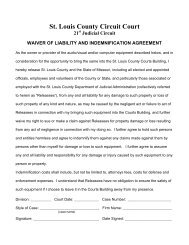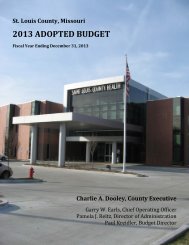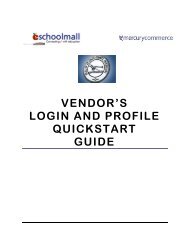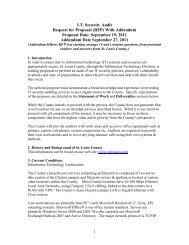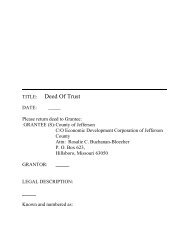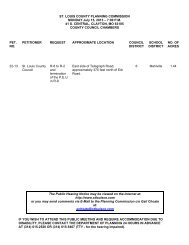2011 budget summary - St. Louis County
2011 budget summary - St. Louis County
2011 budget summary - St. Louis County
Create successful ePaper yourself
Turn your PDF publications into a flip-book with our unique Google optimized e-Paper software.
GLOSSARY & ACRONYMSFair Labor <strong>St</strong>andards Act (FLSA) ‐ Federal legislationregulating minimum wage, overtime, recordkeeping, child labor standards and prohibitingsexual discrimination in pay. 1985 amendmentsapplied FLSA to state and local governments.Fees – see “User Fee”Final Budget – see “Adopted Budget”Fiscal Year ‐ In <strong>St</strong>. <strong>Louis</strong> <strong>County</strong>, the twelve monthsbeginning on January 1 and ending the followingDecember 31. (The <strong>St</strong>ate of Missouri’s fiscal yearbegins on July 1. The federal government’s fiscalyear begins October 1).Fringe Benefits ‐ Fringe benefits include <strong>St</strong>. <strong>Louis</strong><strong>County</strong>’s contribution to Social Security, RetirementPlan, Unemployment Compensation, Workmen’sCompensation, Hospital Insurance, Long TermDisability and Life Insurance.Full‐Time Equivalent (FTE) ‐ A part‐time positionconverted to the decimal equivalent of a full‐timeposition based upon 2,080 hours worked per year(40 hours per week). For example, a part‐timeemploys working 20 hours per week (1,040 hoursper year) is the equivalent of 0.5 of a full‐timeemployee, or 0.5 FTE. A full‐time employee working2,080 hours per year is 1.0 FTE.Fund ‐ An accounting device established to controlthe receipt and disbursement of income fromsources set aside to support specific activities orattain certain objectives.General Revenues ‐ All revenues are generalrevenues unless they are required to be reported asprogram revenues. All taxes, even those that arelevied for a specific purpose are general revenues.All other non‐tax revenues (including interest,grants, and contributions) that do not meet thecriteria to be reported as program revenues shouldbe reported as general revenues.Generally Accepted Accounting Principles (GAAP) ‐Uniform minimum standards and guidelines forfinancial accounting and reporting. They govern theform and content of the financial statements of anentity. GAAP encompass the practice at a particulartime; they include not only broad guidelines ofgeneral application, but also detailed practices andprocedures. GAAP provide a standard by which tomeasure financial presentations. The primaryauthoritative body on the application of GAAP tostate and local governments is the GASB.Governmental Accounting <strong>St</strong>andards Board (GASB)‐ A private, non‐governmental organization which iscurrently the source of generally acceptedaccounting principles (GAAP) used by state and localgovernments in the United <strong>St</strong>ates. It is a private,non‐governmental organization. The GASB hasissued <strong>St</strong>atements, Interpretations, TechnicalBulletins, and Concept <strong>St</strong>atements defining GAAPfor state and local governments since 1984.General Fund ‐ A fund created to account for allfinancial resources for the general operatingrevenue and expenditures of the <strong>County</strong>.General Obligation Bond ‐ Bonds for which the fullfaith and credit of the <strong>County</strong> are pledged.Grant ‐ A contribution of assets (usually cash) byone governmental unit or other organization toanother. Typically these contributions are made tolocal governments from the state and federalgovernments. Grants are usually made for specificpurposes.Intergovernmental Revenues ‐ Revenue collectedprimarily from state or federal governments asgrants, shared revenue, payments in lieu of taxes,or reimbursement for government services.Levy ‐ The total amount of taxes, specialassessments or service charges imposed by agovernment.- 306 -



